Circuit Bending Videogame Consoles as a Form of Applied Media Studies
by Nina Belojevic
published July 2014
1. Introduction:
Last summer, I circuit bent a Nintendo Entertainment System (NES) videogame console as a method of a new applied media study. Rather than analyzing videogames solely at the level of software, graphics, and sound, this process allowed me to understand how the material process of electricity flowing through circuits relates to the video and audio components of games and ties them to histories of labour. Circuit bending is a practice that consists of exposing a circuit board and using wires or other conductive instruments to touch different points on the board together in order to create “glitches” or other effects that are not usually intended behaviours for the device. The hands-on prodding of the circuit board leads to a deeper understanding of the material elements that make up the board. For instance, as I worked on this project, the NES's video random access memory (VRAM) chip broke. Having already begun soldering new connections permanently onto the board, I turned to the Internet to find a replacement chip. Although I was able to find the chip's model number and data sheet, and even managed to find a distributor, I was simply unable to purchase a replacement. These parts were only sold to commercial producers, not individual consumers. Instead of replacing the one broken element on the circuit board, I had to replace the entire board. In the end, I went through three circuit boards in order to produce what, throughout this note, I call a “glitch console,” which exposes and experiments with the materiality and labour at work in videogames and the videogame industry.
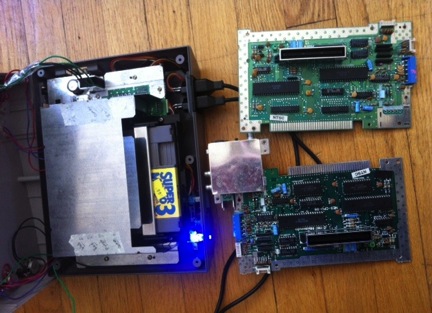
While building a glitch console, it quickly became apparent to me just how difficult it is to fully trace the material elements of a videogame platform. This difficulty raises a number of questions: Where do the parts on the circuit board come from? Whose hands made them? Under what conditions? What happens to the materials in a device once we discard it? Perhaps predictably, these questions do not commonly come up when videogames are studied diegetically, based solely on what is expressed on the screen (Montfort; Kirschenbaum 27-28). However, the material study of hardware offers an approach that highlights material traces that may otherwise go unnoticed by gamers and scholars alike. Furthermore, it prompts an important question in the context of game studies: What do gamers and scholars tend to ignore when they are at once enthralled and distracted by the experiences afforded by the video, audio, and textual elements of games? As I argue below, circuit bending encourages a deep engagement with hardware that offers a materials-first approach and brings awareness to issues of exploitation not commonly raised and recorded by screen-centric analysis alone.
Importantly, the videogame industry relies heavily on the ostensibly “immaterial” labour—practices dependent upon screen-based interactions with their products—of the gaming public for its continued growth and influence in the ludic economy, and thus for individual companies’ profits. Game enthusiasts often spend their free time promoting games and consoles: they discuss them, review them, and produce what is effectively marketing content for game companies, all as part of and in addition to the countless hours these individuals invest in playing the games themselves. As such, the issues of immaterial and affective labour that occur in this sphere have become an important topic in media studies and game studies. The perception of what constitutes play and entertainment, and what constitutes work, have become skewed. As Nick Dyer-Witherford and Greig de Peuter note, the game industry increasingly encourages players to not just play, but also modify their games, thereby increasing engagement, versions of, and changes to games from the free labour of fans and enthusiasts (24-27). Such forms of “playbor” (“play” and “labour”), as iterated throughout Trebor Scholz’s Digital Labor, show how the Internet can be described as both “playground and factory” (26).
While issues of immaterial labour that publications such as Scholz’s draw attention to are vitally important to critical game studies, I want to draw particular attention to the material realities and effects of the videogame industry. The culture cultivated by this industry tends to be shortsighted when it comes to the physical production, consumption, and disposal of videogames. Material resources, labour conditions, and environmental impacts are the elements in our technological devices that we can never fully grasp or uncover; instead, technology users often rely on a socioeconomic structure that supplies them with representations of what they need to know. Ironically, it seems like the affective and immaterial realm might soon become more visible and prominent than material operations and production processes that still occur, often in remote locations. Thus, issues such as the conditions of production that concern individual labourers and the environment are obscured or disregarded realities. Further, the mountains of waste that are an effect of the game industry’s model of product release cycles, which rely on a black-box mentality on the side of users and planned obsolescence on the side of producers, also get displaced into spheres and spaces that those of us in more affluent parts of the world do not usually have to engage or see.
In response to these considerations, this essay proposes hardware hacking, platform modification, and “glitch consoles”—all premised on circuit bending—as practical alternatives to the current industry system of production and disposal. Circuit bending is a practice that is accessible to non-specialists (i.e. hobbyists who do not necessarily have to be engineers to work on hardware hacking projects) and encourages the repurposing of obsolescent materials in a way that facilitates awareness and creative play. Rather than engaging videogames primarily through the screen, hardware hacking also offers a tacit form of interaction often resistant to symbolic or graphical logic. Through circuit bending, the hardware hacker gains a new understanding of material, machinic operations in a particular platform as well as the various materials that comprise a videogame console. Furthermore, by making a glitch console, the hacker potentially complicates the game industry's profit model of exploiting immaterial labour, leisure time, and play—that is, a glitch console can be developed purely for personal enjoyment. Such hacking practices also encourage creative repurposing of ostensibly obsolete technologies, thus offering new uses for devices that may otherwise be discarded.
2. Dispersed Production of Circuit Boards:
As mentioned earlier, an inquiry into the production of videogame console circuit boards shows how the multitude of materials, the dispersed nature of manufacturing, and the lack of public documentation make it nearly impossible to trace back all material elements used in a game console. Console companies such as Nintendo, Sony, and Microsoft design their own printed circuit boards (PCBs), yet the actual manufacturing process is often outsourced to production companies such as the Taiwanese company Foxconn (where the Nintendo Wii U and the Sony PlayStation 4 are produced). The production of a console moves through several stages. It begins with a very detailed design that structures the circuit board. Conductive traces (usually made out of copper) based on the planned design are etched into the circuit board using mass production processes. In many older circuit boards, such as in the NES, holes are drilled into the board and a variety of electrical components, such as capacitors, resistors, and diodes, as well as the integrated circuits (ICs) that run specific operations (such as the VRAM, the CPU chip, and the PPU chip), are soldered into these holes. While the circuit board for a specific console might be manufactured in a single factory, the different electrical components and the integrated circuits are usually produced somewhere else. This approach means that some of the elements are likely to change throughout the production cycle of a given console. No two physical things are exactly alike, and a close, material study with an awareness of singularity recognizes the significance of physical differences and how they affect our understanding of technologies.
In the case of console production, material parts indicate that while users may be able to trace the circuit board back to the manufacturer, it becomes nearly impossible to find out where every element on a particular circuit board comes from. As consumers in middle and high-income economies, most users are typically shocked when confronted with stories about the oppressive practices that underlie the production of common devices. For instance, in late 2012, a news scandal uncovered the exploitative conditions of underaged engineering student interns working at Foxconn to meet the release dates for the Wii U (Moore). A year later, a similar scandal regarding Foxconn’s labour practices reemerged around the production of the PlayStation 4 (Dumitresco). Although these stories work to reveal how the labour conditions at gaming companies can be immensely exploitative, game culture increasingly emphasizes and celebrates the work of artists, designers, and developers. It appears that few gamers are interested to know who soldered the VRAM onto their console’s circuit board, let alone celebrate it as an accomplishment. The widespread lack of interest in the inner workings and production of consoles makes it easy for companies to privilege other elements of games, including narrative and aesthetics. The production process is so dispersed that the material sources and forms of labour that go into the manufacture of consoles have become mere spectres that are impossible to fully trace.
This tendency to ignore the materiality of technological devices, encouraged by the socioeconomic structures and the allure of interfaces, has led to a celebration of immaterial labour. While certain members of the production team in a game development company will commonly be recorded (“Credit Guidelines”), and game modders and artists are lauded in game communities (“Top 10 Game Developers”), the people and resources required to materially produce games are rendered almost untrackable. Scholars such as Lisa Nakamura and Tara Rodgers have shown how certain histories of technologies are buried and scarcely recorded, while others are prominent and canonized. In a chance discovery while searching through archives on well-documented male inventors, Nakamura came across an archived box of materials from Fairchild Corporation’s Semiconductor Division—a company that produced circuits used in calculators, missile guidance systems, and other early computing devices—that revealed how these circuits were almost entirely built by female Navajo workers (Nakamura). Similarly, in Pink Noises, Rodgers refers to the documentary Modulations: Cinema for the Ear, which celebrates male electronic music artists while ignoring the women who “engage in repetitive labor assembling and testing keyboard synthesizers” (14). As such examples suggest, the history and present of electronics manufacturing are filled with selective documentation, rendering some people invisible while others are celebrated.
Circuit bending can function as a method that begins to uncover some of the material realities that are so scarcely documented. By actively taking apart, breaking, remaking, and tinkering with these material devices, hobbyists, hackers, artists, and scholars can engage with, study, highlight, and challenge social justice issues. While the companies that develop and sell consoles have created a system that allows them to maintain a certain level of power and control by pre-determining interactions at the level of screens, controllers, and other interfaces that facilitate immaterial labour, circuit bending challenges such boundaries of interaction. In short, ideologies and interfaces become exposed by the glitch. Rather than relying heavily on symbolic or graphical logic, circuit bending requires a “laying on of hands,” as Nicholas Collins puts it (59). The tacit interaction at the level of electric flow presents itself through screens and speakers as a hiccup, error, or miscommunication. The glitch comes to represent the spectres of materiality, of labour, and of raw materials that have been rendered invisible. However, rather than aestheticizing, fetishizing, or mourning glitches and the spectres they represent, playable glitches enable new modes of play that actively seek to reformulate interactions with machines.
3. Making a Glitch Console:
The practice of circuit bending engages the game’s hardware and in so doing offers a material study of the exposed circuit board while seeing and hearing the effects via the screen and speakers. The hacker studies the platform at the level of transduction to understand how the electrical currents that flow through a board become graphic and sound output. In the process of circuit bending, the hacker also learns about the material makeup and elements of the circuit board. To bend my NES, I went through several steps to learn about the many different elements and intricate functions of the circuit board. After spending ample time learning about circuit bending, the basics of electricity, and electronics safety, I disassembled the console to gain access to the board.
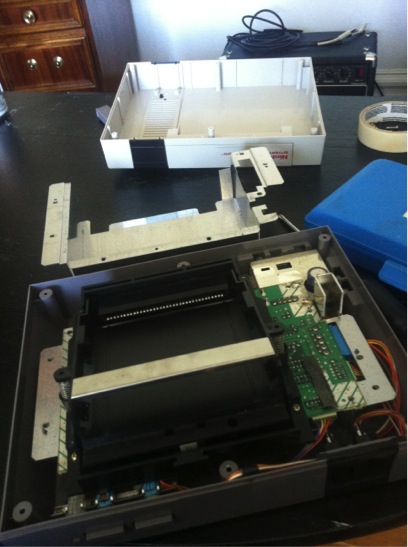
I spent days studying and prodding all the parts of the board using small alligator clips while running a game in order to identify which connections between parts on the board created glitches. Glitches are usually considered undesirable effects, transient system failures, and bugs in electronics, computers, and other platforms (such as videogame consoles). Circuit bending is the process of deliberately creating glitches in an existing platform.
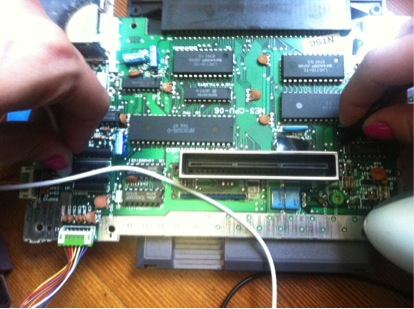
As I learned how the different components of the board worked, I was able to identify playable audio and graphics glitches. While the process of soft circuit bending is incredibly valuable in itself, I wanted to rebuild the NES into a modified, playable glitch console, so I narrowed the glitches down to eight, onto which I soldered switches and potentiometers. In addition to learning about materials in the process of making the glitch console, the playable glitch console functions as a repurposed technology that creatively redefines gameplay and complicates the sphere of interaction.
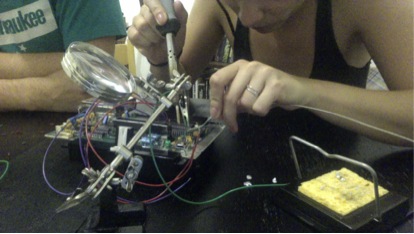
After permanently soldering these connections, I reassembled the console and drilled holes into its plastic casing for the new switches and dials. My personal glitch console was complete.
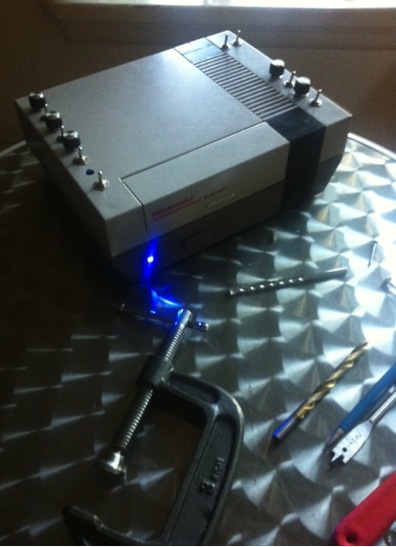
Taking this workflow as an example of how to hack a console, I argue that material engagement with gaming platforms through circuit bending brings awareness to where the parts come from and through what manufacturing techniques consoles are built. Even if we can never fully know the origin of every element in a console, this recognition is itself valuable and encourages a shift in how we interact with technologies.
4. Repurposing Consoles through Creative Play:
When paying attention to the material operations of a device, it is difficult to ignore issues related to industry control and planned obsolescence. Companies build game consoles that are generally not supposed to be opened or altered. Even the design of consoles indicates this expectation. For example, the fan in the new PlayStation 4 is inconveniently placed in a relatively inaccessible part of the console, thereby making something as simple as cleaning the fan difficult without the services of a trained technician. Similarly, the original Gameboy and other Nintendo products use proprietary, three-pronged screws in order to discourage users from opening the plastic casing. More generally, if a game console breaks, then it typically needs to be fixed by a technician, replaced by the company, or simply discarded by the user. Further, the planned obsolescence of games revolves around the regular and highly publicized releases of the latest and most advanced game consoles and titles. While physical consoles may last a relatively long time, new game titles are often only released for the latest platforms—after a short grace period following a console release, the owner of an older system will not be able to find new games on it. This system of release cycles ensures profitability when gamers buy newer models while generating electronic waste when these consumers dispose of their old consoles. Dyer-Witherford and de Peuter note that just like other technological waste, obsolete consoles eventually end up on the “mountainous dumps around the world, especially in Africa, India, and China” (224). This waste is a very material result of an industry that often appears to be situated in the seemingly immaterial realm of narrative, graphic design, and digital play.
Outside the industry-determined framework of play, circuit-bent consoles can be reinvented to assume new forms. Rather than discarding a broken game console or discontinuing use of an obsolete platform, console hacking is a form of creative repurposing that enables customized modes of play. For example, by creating different audio glitches, I am able to play with the sound of videogames and change them in console-specific ways. The device becomes a remixing instrument as well as a game console.
Other circuit benders, such as Jonathan Olaf Johnson, take such forms of play a step further. Johnson's Super Nintendo “Glitch Controller” is a game controller that is attached to a circuit-bent board in a Super Nintendo Entertainment System (SNES) and allows a player to control the glitches while another person plays the game (Johnson). In this approach, the glitch controller adds a videogame-like mechanism for interaction that creates glitches on the screen that Nintendo designers would likely consider errors or distortions.
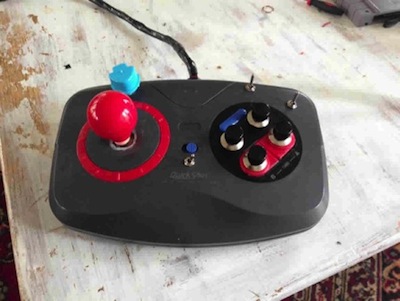
If adopted by the broader gaming public, circuit bending practices such as Johnson’s and my own could reformulate videogame consumption and move gameplay beyond the industry framework for immaterial labour while also redefining play and reducing waste through repurposing. If such practices become more common in gamer communities, I argue that new conversations will begin to take place, and the awareness of material operations, sources, and production issues might become more widespread.
5. Glitch Consoles as Countergaming:
Hardware hacking can be described as a form of game modding, but should be distinguished from software modding, which Anna Anthropy describes as “changing existing games to create new stories” either as a form of critique, personal preference, or improvement of the game (70). As Anthropy writes, such hacks usually take place at the level of software and are made easier by ROMs, through which console games can either be played (using an emulator) or modded, often without coding skills (71–72). However, while such modding offers interesting ways to personalize or critique existing game experiences, it still falls largely within the sphere of gameplay accounted for by the videogame industry. The trend among gaming companies to encourage software modification indicates how even seemingly resistant practices become implicated as value-productive, immaterial labour.
In Gaming: Essays on Algorithmic Culture, Alexander R. Galloway pushes for a more radical hacking in the form of “countergaming” as a way to make “a critique of gameplay itself” (125). He sees hacking as a way to radically change the interactions between player and machine. Although he does not provide examples of such countergaming hacks, glitch consoles offer a route towards exactly that. They intervene through a new critical mode of gameplay that redefines the interfaces and interactions in a manner that foregrounds the physical platform and complicates what is usually considered videogame play. For example, a game mechanics glitch shows how gameplay can be reinvented. In the classic NES version of Tetris, geometric square shapes in a variety of arrangements fall from top to bottom in a particular space and need to be placed in a way that allows as many pieces as possible to fit into that space. The player can turn the pieces clockwise or counterclockwise and move them left or right. Once a piece reaches the bottom or lands on top of another piece, it remains there until a complete row is filled, at which point the row disappears. A game mechanics glitch I generated through my circuit-bent console shifts the placement of the static pieces between two states, adding a mechanic complication to the game. One piece could be placed based on a certain arrangement, but a switch can change that arrangement, shifting the location of available spaces. Thus, rather than assuming that the pieces should remain in a static space, the glitch adds another layer of dynamics to the gameplay. By adding a new game mechanic, this glitch fundamentally changes the rules of Tetris and how it is played. As a form of countergaming, this glitch directly links the mechanics as they appear on screen to the material process on the circuit board.
As a broader practice, hardware hacking enables a creative form of gameplay that does not necessarily follow the routine interactions intended by game companies. As such, circuit bending sparks a critique of ideology and engages in gameplay at its most operational level, without any false sense of transparency or immediacy. By moving interaction toward a consciously embodied, self-reflexive space, play that resists the alienating effects of immaterial or gamified labour is made possible. Additionally, the reformulation of interfaces (from controller to circuit board) also makes a wider range of devices playable. Rather than consuming the latest videogames through the newest interfaces, a modded console can make a novel use of an ostensibly obsolete console.
6. Hardware Hacking as an Actionable Practice:
As Jonathan Sterne explains, “the boundary between durable and obsolete has as much to do with social relations as it does with the decline or decay of the object. Groups of people choose to make an object obsolescent, or they choose to sustain an object long after it would have begun to fall apart on its own” (22). Thus, obsolescence does not necessarily require the device to fall apart, but can be controlled by industry if companies make new devices, applications, and content types incompatible with old ones. In contrast, glitch consoles follow the spirit of what Sterne calls “convivial computing.” The term “convivial” was used by Ivan Illich to refer to characteristics such as “ease of use, flexibility in implementation, harmony with the environment, and ease of integration into truly democratic forms of social life” (Sterne 28). Rather than continuing the current practice of release cycles and planned obsolescence, Sterne imagines “a ‘convivial’ computer, or rather a whole convivial system of digital components, a convivial digital infrastructure” (28). His vision would allow for “digital hardware that is more democratic, slower to change, easier to use, and less damaging to the environment” (29). In line with convivial computing, and skeptical of industry control over interaction and play, hardware hacking prompts democratic engagement with videogames while foregrounding gaming’s socioeconomic and environmental implications.
Large-scale initiatives continue to face challenges when it comes to bringing awareness of material resources and disposal to consumers and shifting industry practices. For example, although Extended Producer Responsibility (EPR) evaluations encourage the makers of consumer products to take back, recycle, remanufacture, or responsibly dispose of their products once consumers choose to discard them, large amounts of waste still get disposed inappropriately, thus causing a variety of environmental hazards. Demanufacturing processes have not been streamlined, suggesting that waste management occurs at varying degrees of environmental protection or damage. For instance, although British Columbia has several e-waste management companies that follow EPR guidelines, instances of shipments to developing countries containing tons of e-waste still occur. In 2011, the Surrey-based company Electronics Recycling Canada (ERC), was caught unlawfully exporting multiple shipments of hazardous e-waste material to Macau, China (Pynn). The ERC shipments contained materials such as lead and cadmium, which can cause physical illness in humans who are exposed to them. As Lisa Parks argues in “Falling Apart,” “the publicization of technological reuse and repurposing in postindustrial societies” is key to engaging the material realities of waste (39-40). While a first step to effecting change lies in bringing awareness to material processes of production and disposal, it must be followed by creative, actionable practices that do not end with consumer guilt.
Hardware hacking can function as an actionable practice in two ways: first, as an applied approach to media studies; second, as an alternative form of play in videogame communities. While scholarship that attends to exploitative labour practices and socioeconomic inequalities is necessary and certainly worthwhile, practical engagement with hardware can afford lines of inquiry and responses beyond strictly theoretical or conceptual paradigms. Furthermore, circuit bending is accessible to public audiences in general and videogame communities in particular. By spreading the practice of hardware hacking through collaborative projects, hackathons, tutorials, publications, and videogame message boards, a shift toward a new kind of gameplay could be encouraged—one that uses a purposefully embodied engagement with technology to encourage both a deeper understanding of materials and a creative repurposing of existing devices.
Works Cited
Anthropy, Anna. Rise of the Videogame Zinesters: How Freaks, Normals, Amateurs, Artists, Dreamers, Dropouts, Queers, Housewives, and People Like You Are Taking Back an Art Form. New York: Seven Stories P, 2012. Print.
Ashcraft, Brian. “The Result of Nintendo's Investigation into Underage Foxconn Workers.” Kotaku. 24 Oct. 2012. Web. 4 Mar. 2014.
Collins, Nicolas. Handmade Electronic Music: The Art of Hardware Hacking. New York: Routledge, 2006. Print.
“Credit Guidelines for New Media.” Producers Guild. Code of Credits – New Media. N.d. Web. 21 Feb. 2014.
Dumitresco, Andrei. “PlayStation 4 Manufacturing Process at Foxconn Involves Unpaid Intern Students–Report.” Softpedia. 10 Oct. 2013. Web. 28 Dec. 2013.
Dyer-Witherford, Nick, and Greig de Peuter. Games of Empire: Global Capitalism and Video Games. Minneapolis: U of Minnesota P, 2009. Print.
Galloway, Alexander R. Gaming: Essays on Algorithmic Culture. Minneapolis: U of Minnesota P, 2006. Print.
---. The Interface Effect. Cambridge, UK: Polity, 2012. Print.
Johnson, Jonathan Olaf. “Building an SNES ‘Glitch Controller’.” Maker Lab in the Humanities. Maker Lab in the Humanities–University of Victoria. 29 Aug. 2013. Web. 20 Oct. 2013.
Kirschenbaum, Matthew G. Mechanisms: New Media and the Forensic Imagination. Cambridge, Mass: MIT Press, 2008. Print.
Kotaku Selects. Kotaku, 1 Mar. 2014. Web. 4 Mar. 2014.
Moore, Malcolm. “14-Year-Olds Employed on Foxconn Factory Production Line.” The Telegraph. 17 Oct. 2012. Web. 28 Dec. 2013.
Montfort, Nick. “Continuous Paper: The Early Materiality and Workings of Electronic Literature.” MLA Convention. Philadelphia, PA. 28 Dec. 2004. Conference Presentation.
Nakamura, Lisa. “Indigenous Circuits.” Computer History Museum. 2013. Web. 21 Feb. 2014.
Parks, Lisa. “Falling Apart.” Residual Media. Ed. Charles R. Acland. Minneapolis: U of Minnesota P, 2007. 32-47. Print.
Pynn, Larry. “B.C. Recycler Faces Charges in Export of Toxic E-Waste.” Times Colonist. 25 Mar. 2013. Web. 3 Dec. 2013.
Rodgers, Tara. Pink Noises: Women on Electronic Music and Sound. Durham, NC: Duke UP, 2010. Print.
Scholz, Trebor, ed. Digital Labor: The Internet As Playground and Factory. New York: Routledge, 2013. Print.
Sterne, Jonathan. “Out With the Trash.” Residual Media. Ed. Charles R. Acland. Minneapolis: U of Minnesota P, 2007. 16-31. Print.
“Top 10 Game Developers of 2013.” Gamasutra. 11 Dec. 2013. Web. 21 Feb. 2013.
Van Rossem, Chris, Naoko Tojo, and Thomas Lindhqvist. “Extended Producer Responsibility: An Examination of its Impact on Innovation and Greening Products.” Report commissioned by Greenpeace International, Friends of the Earth and the European Environmental Bureau (EEB). Sep. 2006. Web. 3 Dec. 2013.

